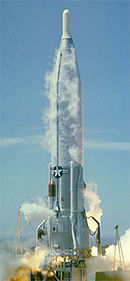 The Atlas-D Able rocket carrying Pioneer P-3, sitting on Cape Canaveral's Launch Complex 14. | |
| Manufacturer | Convair Division of General Dynamics |
|---|---|
| Country of origin | United States |
| Size | |
| Height | 28 m (91 ft) |
| Diameter | 3.05 m (10 ft) |
| Stages | 3.5 |
| Booster stage – Half Stage | |
| Powered by | 2 |
| Maximum thrust | 300,000 lbf (1,300 kN) Atlas D |
| Propellant | RP-1/LOX |
| First stage –Sustainer | |
| Powered by | 1 |
| Maximum thrust | 60,000 lbf (270 kN) Atlas D |
| Propellant | RP-1/LOX |
| Second stage –Able | |
| Powered by | 1 AJ10-37 |
| Maximum thrust | 7,800 lbf (35 kN) |
| Specific impulse | 270 |
| Burn time | 115 |
| Propellant | Nitric Acid / UDMH |
| Third stage –Altair | |
| Powered by | 1 |
| Propellant | solid |
| Capacity | |
| Payload to Trans-lunar injection | |
| Mass | 168 kg (370 lb) |
| Launch history | |
| Status | Retired |
| Launch sites | LC-12,13 &14,Cape Canaveral |
| Total launches | 3 |
| Failure(s) | 3 |
| First flight | 26 November 1959 |
| Last flight | 15 December 1960 |
The Atlas-Able was an American expendable launch system derived from the SM-65 Atlas missile. It was a member of the Atlas family of rockets,and was used to launch several Pioneer spacecraft towards the Moon. Of the five Atlas-Able rockets built,two failed during static firings,and the other three failed to reach orbit. [1]
The Atlas-Able was a three-and-a-half-stage rocket,with a stage-and-a-half Atlas missile as the first stage,an Able second stage,and an Altair third stage. [2]
The first Atlas-Able used an Atlas C as the first stage, [3] and was intended to carry Pioneer P-1,but exploded during a static fire test on 24 September 1959. [4]
The remaining Pioneer launches used Atlas D missiles. Launches were conducted from Launch Complexes 12 and 14 at the Cape Canaveral Air Force Station. One launch was planned from Launch Complex 13;this became the second Atlas-Able to be destroyed during a static firing,and hence never launched. [1]


